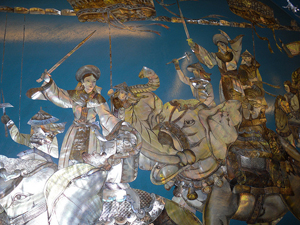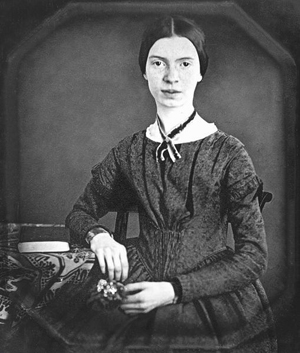In the introduction to this lesson, you learned that a paradox is a statement that seems contradictory but actually expresses a possible truth. A paradoxical statement may seem to defy logic on the surface, but upon closer reading reveals insight into words that may have seemed like opposites at first. Consider these lines from the following poem:

Source: Women go to war, Dekcuf, Flickr

Source: Alice_Walker, Virginia DeBolt, Wikipedia
Women
by Alice Walker
They were women then
My mama’s generation
Husky of voice—Stout of
Step
With fists as well as
Hands
How they battered down
Doors . . .
How they led
Armies
Headragged Generals
Across mined
Fields
Booby-trapped
Ditches
To discover books
Desks
A place for us
How they knew what we
Must know
Without knowing a page
Of it
Themselves.
Who were these women? Were they literally soldiers battling in war? Could it be they were fighting for something else? Walker suggests at the end of the poem that they were battling “To discover books/Desks/A place for us.” In other words, these women were striving for education. If you noticed “must know/without knowing” in the last few lines, then you are a great paradox detective. In these two lines, Walker suggests that even though these women were uneducated, they realized the importance of education and were willing to fight for it.
In the activity that follows, you are presented with paradoxes from famous poems. Choose the words that complete the paradox from each drop-down menu.

Now, let’s read the paradoxical poem “I’m nobody! Who are you?” by Emily Dickinson. Knowing a little bit about Dickinson’s life may help you understand the poem and its irony.
Dickinson lived from 1830 to 1886 in Amherst, Massachusetts. She lived in her father’s home and never married. Over time, she gradually stopped leaving the house. Although she isolated herself from the world physically, she wrote many letters and read widely. She also secretly composed over a thousand poems, which were discovered by her sister after Emily’s death. Since her poems were only published posthumously, she remained unknown as a great poet during her lifetime and received no public recognition.

Source: Emily Dickinson daguerreotype (cropped), Wikimedia
I’m nobody! Who are you?
by Emily Dickinson
I’m nobody! Who are you?
Are you nobody, too?
Then there’s a pair of us—don’t tell!
They’d banish us, you know.
How dreary to be somebody!
How public, like a frog
To tell your name the livelong day
To an admiring bog!
 Use your notes to answer each question about the poem. When you are finished, check your understanding to see a possible response.
Use your notes to answer each question about the poem. When you are finished, check your understanding to see a possible response. - Dickinson sets up two important contrasts in the poem. One of those contrasts is between “nobody” and “somebody.” What is the other?
- Consider the contrast between “nobody” and “somebody.” We think of “a nobody” as a person of no importance. Once a person has become successful, we might call that person “a somebody.” However, the speaker in the poem describes being “a somebody” with what negative word?
- An important part of irony is surprising or even shocking the reader. In this poem, the speaker startles the reader by comparing “a somebody” to what creature?
- The speaker says that to be somebody, you must “tell your name the livelong day / to an admiring bog.” What is the speaker trying to convey about “somebodies” and their fan bases? Hint: Think about contemporary somebodies and their fan bases, and remember that Dickinson was never famous while she lived.
- What is the paradox in this poem?
Sample Response:
Dickinson also contrasts “us” and “they.” She says, “Then there’s a pair of us — don’t tell!/They’d banish us, you know.” You might also have said that she contrasts the private life (that of a nobody) with the public life (that of a somebody), proclaiming her preference for the private life.
Sample Response:
Dickinson writes that it’s “dreary to be somebody.” This is ironic because the reader probably doesn’t think of well-known people or celebrities as having boring lives.
Sample Response:
The speaker compares “a somebody” to a frog—not a very glamorous or appealing creature—croaking its name all day long.
Sample Response:
Perhaps she is suggesting that “a somebody,” like a frog, must constantly announce its presence to hold onto its “admiring bog.” A frog’s croaking can be repetitious and irritating, a good analogy for people who sing their own praises to make their names known. The “bog” in the poem could be the not-very-smart fans. Dickinson must not have held the public in high opinion because a bog consists of decaying vegetable matter.
Sample Response:
Dickinson suggests that being “nobody” is better than being “somebody.” Even though this idea seems contradictory, it can be a truth for many people and a way they choose to live their lives.
In this poem, Dickinson may be claiming that, ironically, the true somebodies in life are the nobodies. She was a master of using paradox and irony to reveal a great truth.
In this lesson, you have identified and analyzed the purpose of irony and paradox in poetry in the works of Emily Dickinson, Walt Whitman, Carl Sandburg, and others. As you read, look for these two devices and keep the following words in mind:
Irony—sometimes comic, sometimes tragic, sometimes wry or perplexing—provides additional richness to the literary dish. And it certainly keeps us readers on our toes, inviting us, compelling us, to dig through layers of possible meaning.